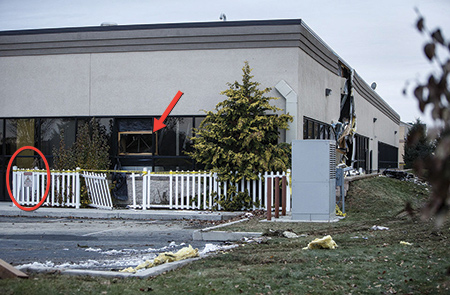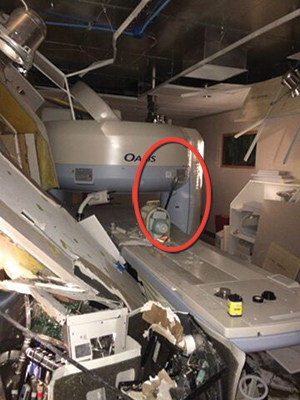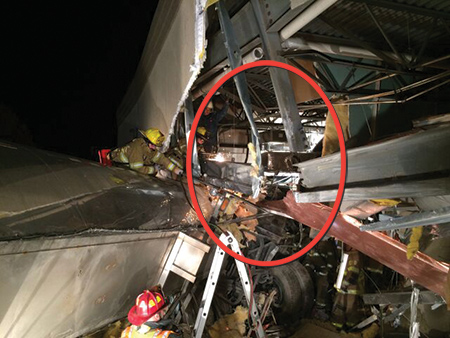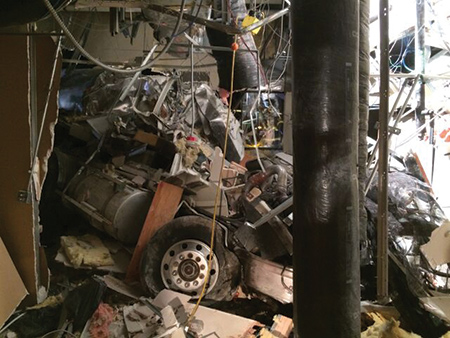by RANDY PADFIELD and GEORGE STAPLETON
At 2305 hours on Monday, December 1, 2014, Cumberland County (PA) Companies 41 and 36 and Rescue 45, Cumberland-Goodwill Emergency Medical Services (EMS), and Yellow Breeches EMS units responded to an accident involving an overturned tanker truck on Interstate 81 North at mile marker 45 in South Middleton Township, Cumberland County. Volunteer fire and career EMS services provide most of the protection for this area. Shortly after the initial dispatch, the Cumberland County dispatch headquarters advised responding units that the tanker truck had left the interstate and crashed into a structure at 2 Jennifer Court, across the street from the area hospital, the Carlisle Regional Medical Center. The vehicle accident alarm assignment was upgraded to a structure alarm response, and redirected units found a tractor trailer milk tanker embedded in a commercial structure with reported entrapment (photos 1 and 2; Figure 1).
![(1<b>, 2) </b>The building's C side. The tanker rolled onto the driver's side and penetrated the building. [Photo 1 courtesy of Cumberland County (PA) Coroner's Office; photos 2-7 by Randy Padfield.]](https://emberly.fireengineering.com/wp-content/uploads/2015/09/1509FE_PadfieldPhoto1.jpg) |
| (1, 2) The building’s C side. The tanker rolled onto the driver’s side and penetrated the building. [Photo 1 courtesy of Cumberland County (PA) Coroner’s Office; photos 2-7 by Randy Padfield.] |
However, this was no ordinary commercial structure-it housed an outpatient imaging center containing a magnetic resonance imaging (MRI) unit, a radiological imaging center, and a pain clinic. The involved structure was a single-story, steel-frame building with nonload-bearing exterior curtain and interior partition walls, sitting on a concrete slab with a corrugated steel/composite roof deck supported by steel bar joists. The resulting response and recovery operation proved challenging for rescuers as they attempted to operate within this damaged structure and in close proximity to a live magnetic field from an MRI unit.
Arrival and Size-Up
Within eight minutes of dispatch, arriving units (Engine 141, Rescue 45, Chief 45, and Chief 141) established command and conducted an initial size-up. They found a fully loaded, 6,000-gallon milk tanker had left northbound Interstate 81, traveled down an embankment, and crashed into the C side of the facility that housed the MRI unit. Pennsylvania State Police personnel and a medic unit arrived prior to the fire department and broke glass on the structure’s D side entry doors in an attempt to locate the driver.
 |
| Figure 1. Aerial View of MRI Facility |
The size-up confirmed that approximately 70 percent of the tanker was inside the structure. Several interior walls had been breached, and the interior doors leading from the interior hallway into the MRI suite and control room were damaged and unusable. Initial reports also indicated the possibility that the tractor had breached the walls into a room housing the MRI unit. With arriving personnel from the upgraded first alarm assignment (Engines 136 and 336 and Truck 45), command’s initial operations concentrated on the following priorities: establishing a water supply and stretching interior and exterior suppression lines; securing building utilities; requesting a dedicated rapid intervention team (special-called though mutual aid); evaluating the damage to the structure; and forcing entry into the building’s inaccessible areas to locate the trapped driver and formulate an extrication plan. During these initial operations, personnel encountered significant challenges related to the unique features associated with the MRI unit and the impacted structure.
Challenges
The truck had penetrated through the rear wall (C side) of the structure; most of the cab came to rest inside the MRI control room, damaging all access doors into the MRI suite that housed the MRI unit.
Forcible entry and breaching operations into and around the area of the MRI room became problematic when firefighters attempted to use a saw to cut an interior opening into the drywall to locate the tractor cab. Instead, they encountered the metal radio frequency (RF) shielding that encapsulated the MRI suite (photo 3).
 |
| (3) The interior hallway shows damage to the partition walls; forcible entry was frustrated by RF shielding. |
Instead of cutting the RF shielding, personnel removed the hallway doors to the MRI suite and the MRI control room. On entry, crews confirmed the interior B side wall of the MRI exam room (located on the C/D corner of the structure) had been damaged. However, personnel were unable to determine if the MRI suite RF shielding had been breached in the area of impact.
Diesel fuel leaked from the saddle tanks on the structure’s C side where the truck impacted it and internally within the control room and MRI suite. Personnel observed diesel fuel pooling within the subfloor of the MRI control room.
The accident caused significant structural damage to the outside of the building as well as damage and collapse of interior building components. It also caused the clean-agent fire extinguishing system to discharge within the MRI suite and adjacent control room.
 |
| (4) The side C/D corner. The sign on the fence warns of the presence of a magnetic field (circle). A firefighter made entry through the window (arrow), and the magnetic field pulled his halligan from his hands. |
The loss of electrical power and a significant amount of airborne particulate required the extensive use of portable lighting and positive-pressure ventilation to improve safety and visibility during the extrication. Any access to the driver was hampered because of the extensive damage to the cab tractor and the amount of structural debris covering the cab. Firefighters used multiple ladders on the interior of the building to assist crews in scaling the remnants of the tractor cab.
With the driver’s location still unknown and the possibility the driver may have been ejected inside the structure, two firefighters were ordered to force entry through a window on the D side of the structure that led directly into the MRI suite (photo 4). As they entered through the window, one firefighter’s halligan bar was forcibly pulled from his hands and became a flying projectile, traveling approximately three to four feet and lodging tightly against the MRI unit (photo 5). These firefighters immediately exited that area, and all access to the MRI suite was restricted. Command requested immediate assistance from the hospital to shut down the MRI unit’s magnetic field.
 |
| (5) The interior of the MRI suite. The tractor cab damaged the left wall. The circle shows the halligan that the magnetic field pulled out of the firefighter’s hands. |
But the accident had destroyed all of the electronic circuitry to the MRI unit, so all emergency controls were inoperable. Even though power was shut down throughout the building, the MRI remained magnetized, and rescuers could not disable the MRI’s magnetic field.
The accident caused significant structural damage to the building’s C side, calling into question the structural integrity in the immediate area of rescue operations. One steel column had been completely severed from its base. Damage occurred to a supporting beam that ran along the same side of the building above a series of windows. This created a large unsupported opening in the structure that compromised the load path to the ground for the steel bar joist supporting the roof structure (photo 6).
 |
| (6) Note the damage to the steel beam (red) and vertical column, resulting in the loss of the load path to the ground (circle). |
Because of the incident’s complexity, Team 500, the Cumberland County Technical Rescue Operations Team (TROT) was dispatched. The TROT draws it members from numerous fire and EMS companies throughout the county. A technical rescue branch was established with Chief 500 and 501.
Rescue or Recovery?
The extensive damage to and distortion of the cab from the crash made it difficult to identify vehicle components that would normally assist personnel in locating and accessing the driver’s compartment. The number of occupants was unknown. If the driver and any passengers remained inside the cab during the crash, they were heavily entrapped (almost encapsulated) within the driver’s compartment.
Access to the cab’s passenger side was also limited. The driver’s side of the cab was wedged tightly against the MRI control room wall. To access the driver’s side of the cab, personnel had to crawl either over or under the tractor through the diesel fuel. Rescue efforts thus had to be made from the top of the cab down into the driver’s compartment (photo 7).
 |
| (7) The interior of the building with the tractor cab sitting in the electrical/equipment room adjacent to the MRI suite. |
Personnel operating two reciprocating saws and a hydraulic rescue cutter removed small sections of the debris field and parts of the tractor cab to tunnel down and reach any occupants. As debris was removed, firefighters used a human chain to remove large structural components and buckets to remove smaller debris out of the control room and into the hallway. Approximately one hour into the extrication, crews found the deceased driver heavily entrapped in the cab. Command immediately shifted operations from a rescue to a recovery effort.
As command notified the Cumberland County Coroner’s Office and the Pennsylvania State Police, which began the crash investigation, the incident commander, the county coroner’s office, TROT command personnel, an on-scene MRI technical specialist, and local towing/salvage service personnel developed a unified recovery plan. Because of the amount of structural damage, limited interior egress, and close proximity of the MRI unit, it was determined that the best recovery option was to remove the vehicle from the structure and complete the extrication from the relative safety of the building’s exterior. This plan included arranging for the transport company that owned the truck to transfer the milk to another tanker on the interstate.
As personnel awaited the completion of the milk transfer, a TROT urban search and rescue structural specialist assessed the building’s structural stability to address any issues that would further compromise it during the vehicle’s removal. Team 500 personnel assisted in cutting and removing the remainder of a damaged steel column as well as a span of steel beam at the rear wall approximately 12 inches above the milk tank (photo 6). The concern was the truck might contact the beam during removal and possibly damage the adjacent column and beam attachment point, which was still intact and structurally stable.
The cutting/burning operation consisted of a series of three- to four-foot cuts using an oxyacetylene cutting torch. Because of the fire hazards present (diesel fuel and building debris) below the cutting area, a charged 13/4-inch line provided fire protection throughout the operation. The team also cut and removed a portion of the tanker’s ladder rack to ensure the tanker would not hang up on portions of the remaining rear wall during removal.
Removal from Building
Two heavy wreckers with rotating booms removed the tractor trailer and tanker. The towing crews determined that the tractor and trailer could not be disconnected and the entire unit had to be removed simultaneously from the building. One wrecker, positioned along the interstate, would pull directly rearward on the tanker. The other, positioned to the rear of the building at approximately 90° to the tanker, would sling and rotate the tanker as it was removed.
During the removal, interior personnel acted as spotters to assess any impact to the building’s structural stability and to ensure the cab and the victim were removed intact. Once the entire vehicle was removed, approximately seven hours after dispatch, personnel completed the final disentanglement and removal of the victim. The scene was released to the building owner, and all units returned to service. No injuries to personnel occurred during the response or recovery operations.
Incident Critique
Although this was an unusual incident, all agreed that the cooperation and teamwork among the responding units on the scene were superb, as these companies routinely work together. Several weeks after the incident, responders, hospital personnel, and a technical specialist from the MRI manufacturer conducted a formal after-action review of the incident.
Following are some of the observations made regarding the incident.
- Understanding the complexities of the MRI unit was critical to the success and safety of all emergency responders.
- Technical assistance was vital early in the incident.
- Dispatching technical rescue teams early in the incident provided the needed staffing and technical support that led to a safe outcome. The incident was labor-intensive and required numerous agencies to mitigate the hazards.
- An effective incident command system (ICS) was implemented early in the incident.
- Cumberland County’s public information officer provided periodic news briefings to the media, relieving command of that responsibility.
Lessons Learned
This unusual, complex incident provided a number of lessons for all personnel and agencies involved.
- Although incidents involving MRI units are rare, emergency response personnel need to understand some of the complexities of dealing with such emergencies to safely and effectively operate at them. Agencies should preplan a response to an MRI incident and develop a list of best practices for responding to a variety of MRI emergencies. Preplanning is the key to success.
- The MRI unit’s magnetic field is constantly on, even if the emergency stop/power button to the power distribution unit may have been activated or the building’s power has been isolated or secured. Always anticipate that the magnetic field is present when conducting emergency operations around an MRI unit. Make sure that no metal objects containing ferrous metals or ferrous metal compounds come anywhere near the MRI unit or inside the room that contains the MRI. This includes forcible entry tools and many of the tools engine, truck, and rescue companies carry. The minimum stand-off distance varies, depending on the strength of the magnet.
- “Quenching” an MRI magnet-i.e., exhausting the liquid helium or other inert gas used to cool it and thus disabling the magnetic field-is an expensive proposition. In making this decision, when possible, work with technical specialists and medical facility representatives. Repairing a quenched magnet can cost the medical facility approximately $40,000.
- Magnets should only be “quenched” using the “magnet stop” button/switch located within the imaging suite if it is a dire emergency and personnel cannot safely conduct operations with the magnetic field present. Several hours into the incident, we found the emergency quench button in the rubble, but it would not operate. The responding MRI technician consulted with numerous offsite personnel because he was unable to manually quench the unit using the installed emergency systems normally used. The emergency procedures to deal with incidents involving multiple system failures have yet to be written.
- If you need to quench the MRI magnet and the unit has suffered some sort of physical stress, check the vent stack’s integrity prior to initiating a quench sequence. There were serious concerns over possible damage to the vent piping from the crash and the possibility of dumping cryogenic liquid helium back into the MRI room during the emergency quench sequence. After looking at all contingencies, it was decided that the quench venting would be delayed until after all fire and rescue operations were complete. Ten hours after the crash, the on-scene MRI technician used a direct-current battery source to activate the solenoid valves to exhaust the liquid helium. The emergency quench sequence was successfully completed without incident.
- MRI suites can have various types of shielding in the walls surrounding the units-RF shielding, magnetic shielding, or a combination of both, depending on the magnet’s strength and the size of the room/suite. The RF shield usually is ¾-inch pressed wood with a thin layer of galvanized steel on both sides. Besides the RF shield, a magnetic shield can have an additional layer of thin steel. A magnetic shield keeps the magnetic field within the room and prevents it from leaking outside. The shield’s thickness depends on the room size and the type of magnet. Avoid breaching the walls of the MRI suite if at all possible. If you need to breach the walls of the suite, be prepared to encounter wall reinforcement, which will require extended time and additional tools and equipment to complete the operation.
- Personnel working in close proximity to a magnetized MRI machine could see magnetic data erased from credit cards, magnetic strips on identification badges, thumb drives, and other media with magnetically stored data.
- When responding to situations involving an impact or physical damage to a structure, ensure that a qualified structural engineer assesses the building’s structural integrity to determine the need for shoring or hazard mitigation before attempting extensive rescue or recovery operations.
- The key to success for complex or unique incidents is involving all the key decision makers in developing the plans to mitigate the situation. This includes using a technical specialist when/where applicable for situations that are outside of our normal operations, such as any outside resources. For example, offloading the milk was delayed because of incompatible electrical connections needed to power the transfer and because the tanker sent to accept the offloaded milk was of lesser capacity than the original tanker. Establish a liaison with outside resources to ensure all operations are coordinated.
Although the incident above posed some significant response and recovery challenges because of its specific hazards, use of the ICS, early recognition of the MRI magnetic field’s hazards, involving technical specialists in the recovery plan, and coordinating all agencies and stakeholders ensured its success.
MRI Basics and Safety
MRI scanners are commonly used in medicine to support the diagnosis and the treatment of many medical conditions. Because of the scanners’ widespread use, many medical facilities (both in-hospital and outpatient) use either fixed or mobile units, increasing the likelihood that emergency services organizations will respond to an incident involving an MRI unit.
An MRI uses an extremely strong magnet, along with radio waves and a computer, to take very detailed images of the inside of the body. To create the magnetic field, electricity passes through coils of wire, which are cooled using liquid helium, a cryogenic gas, to eliminate electrical resistance so the magnetic field exists all day, every day, even when the unit is not in use.
The magnetic field’s strength is usually measured in Tesla (T) or Gauss (G). One T is equal to 10,000G. Most MRIs today range from 0.1T to 3T. In perspective, a 3T magnet is 60,000 times stronger than the earth’s magnetic field. Because of the MRI’s extremely strong magnetic fields, personnel must take serious safety precautions while working near an MRI room. Any items containing ferromagnetic metals, iron, nickel, or cobalt must never be brought into the MRI room. Any loose items containing ferromagnetic metal brought near an MRI machine can become dangerous projectiles with extreme speed and power. Anyone with a pacemaker implant, defibrillator, cerebral aneurism clip, or hearing implant containing ferromagnetic metal should never enter an MRI room.
MRI rooms are marked with signs and have two buttons for emergencies. One is an emergency stop/off button, which turns off all incoming electrical power to the magnet’s power distribution unit. Shutting down power may be required for a fire in the computer room, fire or sparks in the scanning room, flooding or sprinkler system activation, or catastrophic equipment failure. The other emergency button is the quench button, which will cause a collapse of the superconductive magnetic field within minutes.
When the system is quenched, all of the cryogenic liquid coolant is offgassed to the exterior of the building by roof or side wall vent pipes. If the pipes fail during a quench, frigid helium can discharge into the MRI room. Liquid helium is roughly -450°F and can cause severe cold burns. Pressure in the room will increase dramatically, and the oxygen will be depleted as the gas expands. Asphyxia will become a strong concern. Oxygen levels must be monitored to ensure a safe environment.
Usually, the only time a magnet is quenched is when a large metallic object pins or impales a person and there is no other method to prevent further injury or to free a person. There is a possibility of an uncontrolled quench, which happens automatically because of a component failure or malfunction. There are also some permanent magnets that cannot be quenched, usually older lower-field-strength (0.3T) magnets. Each facility will have a protocol on who is authorized to quench an MRI unit.
You can perform fire and rescue operations safely around an MRI unit by maintaining an equipment distance of at least 10 feet, although this may vary, depending on the strength of the magnet. Fire department personnel should never enter an MRI room unless they are completely metal free or the system has been quenched.
RANDY PADFIELD is chief of the Cumberland County (PA) Technical Rescue Team 500 and the director of the Senator John J. Shumaker Public Safety Center at Harrisburg Area Community College. He is a task force leader with PA-TF1 urban search and rescue team.
GEORGE STAPLETON is an assistant chief with the Citizens Fire Company No. 1 (Cumberland County Station 36) and is the administrator at the Pennsylvania State Fire Academy.
Electrical Hazards: Is Your Department Prepared?
ELECTRICAL SAFETY ON THE FIREGROUND
Construction Concerns: Electrical Service Hazards


